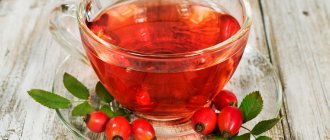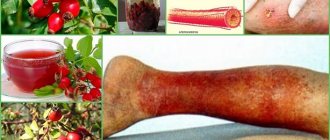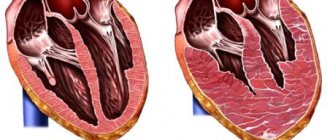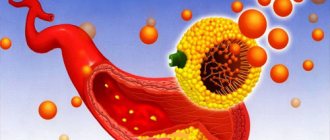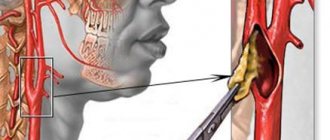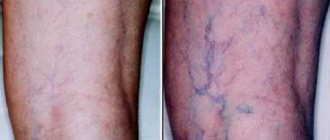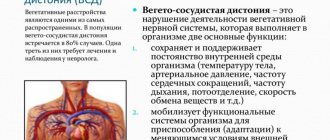Treatment of atherosclerosis is always complex and consists of taking medications, lifestyle changes, and maintaining a regular diet. Often, in addition to traditional therapy, doctors prescribe traditional medicine. Collections and infusions have a positive effect on the state of the circulatory system, help normalize sleep, find peace of mind, and lower blood pressure. However, it is necessary to take natural medicines for atherosclerosis of the heart vessels strictly as prescribed by the doctor - some herbal components negatively affect the medicines, reducing their effect.
What is atherosclerosis
Atherosclerosis is a chronic disease in which cholesterol deposits and plaques form on the inner walls of blood vessels. Changes in the wall surface lead to a loss of elasticity in the vessel, which increases the risk of ruptures and internal bleeding. Pathology is the main cause of cardiovascular diseases, and ranks first in many countries in the world in terms of mortality.
The danger of the disease lies in its long asymptomatic development and difficult diagnosis in the early stages. Rapid spread is possible against the background of:
- elevated blood cholesterol levels;
- hypertension;
- diabetes mellitus;
- excessive smoking and alcoholism.
The causes include:
- obesity;
- heredity;
- cholelithiasis;
- frequent stress;
- physical inactivity;
- bad environment;
- binge eating.
When there is an excess amount of cholesterol in the blood, an atherosclerotic plaque is formed from fats, calcium and LDL. This is dangerous because when the plaque ruptures, lipid thromboembolism and atherosclerotic aneurysm can occur. Typically, these changes occur in the aorta, heart, lower extremities, brain, and kidneys.
Symptoms
The manifestation of the disease depends on its location. When the coronary arteries are damaged, the balance between the heart's need for blood flow and its actual volume is disrupted. Atherosclerosis of this area is expressed in angina and heart attacks.
If there are problems with the blood vessels of the brain:
- decreased performance and concentration;
- memory impairment;
- fast fatiguability;
- tinnitus and hearing loss;
- dizziness;
- impaired coordination of movement.
With atherosclerosis of the aorta, pressing pain appears behind the sternum, which can radiate to the neck, back and arms. The pain lasts a long time, and its intensity varies.
The development of atherosclerotic plaques in the mesenteric arteries manifests itself as:
- nausea and vomiting with bile;
- constipation;
- gas formation;
- blood in stool.
The main symptoms of atherosclerosis when the vessels of the legs are affected are intermittent claudication and dry gangrene.
Not only clinical symptoms, but also complications depend on the type of disease. Damage to the limbs can lead to the loss of a leg or arm; atherosclerosis of the cerebral vessels, if not treated correctly, results in disability, and of the heart - coma and death.
Reasons for the development of pathology
The main cause of the development of aortic atherosclerosis is cholesterol deposition. A number of factors lead to this:
- Gender of a person
The disease affects men more. The thing is that before the onset of menopause, women produce large quantities of the sex hormone estrogen. It is actively involved in cholesterol metabolism. In simple words, it helps break down harmful fats. Men have no such protection. Therefore, up to 50 years of age, men are more likely to suffer from atherosclerosis. When menopause occurs, hormonal imbalances occur in the female body and estrogen production decreases. As a result, the risk of atherosclerosis will increase in women.
- Age-related changes
With age, all people's bodies age. Blood vessels become less durable and elastic under the influence of multiple factors. At the sites of damage to blood vessels, a loose wall is formed, where it is much better for cholesterol to adhere.
- Heredity
Man, unfortunately, cannot change his genome. If there were relatives in the family with a similar disease, then the person is at risk.
- Bad habits
Smoking and excessive alcohol consumption are a direct path to aortic atherosclerosis. Tobacco smoke and ethanol molecules are the strongest poisons for the body. Toxins poison it, disrupting blood circulation, deforming blood vessels, including the aorta.
- Hypertension
People suffering from hypertension (also called arterial hypertension) are susceptible to the development of atherosclerosis of the aorta. Hypertension is accompanied by constant surges in pressure. Mostly it is high. At the same time, the blood puts very strong pressure on the walls of the blood vessels, damaging them, making them more vulnerable to narrowing and the formation of cholesterol plaques.
- Overweight
Extra pounds lead to disruption of fat metabolism. At the same time, the balance of “good” and “bad” cholesterol is also disrupted. The result is the formation of plaques in the aorta and atherosclerosis.
- Diabetes
This is an endocrine disease accompanied by impaired carbohydrate metabolism. In the body of people with diabetes, such disorders are necessarily accompanied by disruptions in fat metabolism. A person diagnosed with diabetes is much more susceptible to atherosclerosis than healthy people.
- Sedentary lifestyle
Sedentary work and lack of sports lead to stagnation of blood in the vessels. Their deformation and circulatory disturbances occur, which leads to atherosclerosis of the aorta of the heart.
- Infectious diseases
It became known not so long ago that viruses and bacteria can cause atherosclerosis. But still this is a proven fact. People who often suffer from various infectious diseases are at risk for atherosclerosis. Hepatitis and herpes can provoke pathology.
- Stress
Nervous tension caused by stress is accompanied by the production of large amounts of adrenaline. It has a very dangerous effect on the body: it generates oxygen molecules, which in turn make cholesterol molecules sticky. At high concentrations, fat cells begin to adhere to the wall of the aorta. Therefore, emotional people are more susceptible to aortic atherosclerosis than others.
- Poor nutrition
Fast food, fried, smoked foods contain trans fats. Once in the body, they cause not only atherosclerosis, but also the formation of free radicals. By the way, a fried crust on meat is nothing more than bad cholesterol.
As you can see, multiple causes can become the trigger for the development of aortic atherosclerosis. When exposed to the above factors, damage to the aortic wall occurs. In these places, platelets (red platelets of blood) accumulate and are destroyed. The destruction of platelets is accompanied by the release of active substances, due to the impact of which the muscle cells of the aorta become denser. The result is the formation of atherosclerotic changes in the aorta.
Traditional treatment of the disease
Doctors confirm the diagnosis based on the results of laboratory and instrumental tests. And treatment depends on the identified stage of the disease.
If an initial or moderate degree is diagnosed, then drug therapy with mandatory physical therapy and diet is usually prescribed. If the disease is in an advanced stage, the patient is referred for surgery to save life.
Drug therapy for atherosclerosis is aimed at normalizing lipid metabolism, correcting diabetes mellitus, arterial hypertension and other third-party chronic processes. Basic medications are divided into several groups depending on their purpose and mode of action.
The main group is statins. They lower cholesterol levels and stop the growth of atherosclerotic plaques. The effectiveness of taking the drugs appears within 2-3 months. Medicines from the fibrate group are used to reduce the volume of triglycerides in the blood. Inhibitors or beta blockers are prescribed to reduce the heart's oxygen demand, myocardial activity and severity of disease symptoms. Vitamin preparations based on nicotinic acid and its derivatives lower cholesterol and triglyceride levels, while simultaneously having a positive effect on the growth of high-density lipoproteins.
Antiplatelet agents are prescribed less frequently and in combination with other drugs to prevent gluing and sticking of platelets and red blood cells to the inner surface of blood vessels. The result of taking medications is the release of blood flow. Anticoagulants are prescribed to thin the blood and reduce the risk of blood clots. Bile acid sequestrants are prescribed to bind fatty acids in the intestines. Antihypertensive drugs are indicated for people with high blood pressure.
Surgical intervention
In complex and advanced cases, when the patient’s life is in danger, surgery is prescribed instead of cardiac conservative treatment. Surgeons use 2 methods of surgical treatment: open and closed. When open, the vessels are opened to remove the plaque or straighten the area of tortuosity. When closed, the operation is performed through a small puncture: a stent or balloon is inserted into the vessel, breaking the plaque and freeing blood flow.
Specific and nonspecific symptoms
The development of this disease involves the manifestation of certain symptoms at each stage:
- the appearance of lipid deposits on the walls of arteries;
- the formation of formations of a dense structure (atheromas, or plaques), consisting of fats and cholesterol;
- gradual narrowing of the vessel;
- necrosis;
- destruction of plaques;
- the appearance of blood clots.
Necrosis, leading to the destruction of plaques, provokes bleeding at the site of the destroyed vessel walls. This can be fatal.
With atherosclerosis, symptoms can manifest themselves in several organs and systems of the human body. Therefore, a doctor can confidently say that a patient has atherosclerosis based only on clinical symptoms.
So, atherosclerosis may be indicated by:
- IHD (coronary heart disease, when the rhythm is disturbed and a person experiences pain in the heart area during various types of stress);
- often high blood pressure;
- memory problems;
- decreased concentration;
- frequent leg fatigue;
- feeling of heaviness in the legs;
- trophic ulcers on the legs.
If atherosclerosis develops on the lower extremities, then usually the hair on them disappears, and the wounds that appear there (even ordinary scratches) do not heal for a long time.
Usually, the attending physician, taking these symptoms into account, prescribes additional tests.
There are also nonspecific signs of atherosclerosis, which can be identified during the initial examination.
- Noise in the area of the arteries.
- No pulsation in the legs.
- Hard walls of blood vessels (this can be determined even by palpation).
The doctor can make a final diagnosis by taking into account the totality of all signs and laboratory test results.
According to statistics, atherosclerosis most often affects men. The number of sick women is several times smaller.
Moreover, the optimal age of sick people exceeds the 50-year mark. The development of this pathology is explained by the fact that at the age of 45-50 years the hormonal levels in the human body are completely restructured.
The production of sex hormones decreases, thereby inhibiting the protective function of the immune system. Also at this age a person becomes more susceptible to stress.
The work of the gastrointestinal tract organs slows down and metabolic processes in the body are partially disrupted.
Symptoms of atherosclerosis can be completely different deviations and disturbances in well-being, since everything depends on the degree of damage to the vessel and the location of the fat accumulations.
Diagnosing this disease is a very difficult process. The main and initial method is a blood test for cholesterol.
In case of elevated values as a result of the analysis, it is worth undergoing an examination of the heart and all components of the circulatory system.
If there is atherosclerosis, it is difficult for a person to swallow and breathe. Severe headaches, frequent pressure changes and changes in the aortic arch are observed.
The structure of the skin on the face changes due to the appearance of fatty patches on the surface. In appearance, signs of aging such as gray hair and excessively dry skin appear sharply.
Atherosclerosis of cerebral vessels causes dizziness due to oxygen starvation of cells, which, if not treated promptly, can lead to a stroke.
Atherosclerosis of peripheral vessels is manifested by dry skin, sudden weight loss and exhaustion of the body, pain in the limbs and weakness. In the case of atherosclerosis of the extremities, resolution of all tissues and skin is observed, which leads to gangrene.
Atherosclerosis causes heart failure, arrhythmia, and severe pain in the heart. The worst case of this disease is myocardial infarction. Thrombosis of fatty plaques causes oxygen starvation of tissues and inhibits many processes in the body.
Treatment with folk remedies
Patients with heart disease are advised to adhere to a special diet, give up bad habits and exercise. At the same time, doctors prescribe traditional medicine in the form of tinctures, teas, decoctions, compresses, etc.
Herbal medicine or herbal medicine has a number of positive properties:
- increasing the effectiveness of medications;
- elimination of symptoms of the disease without the risk of complications;
- improvement of well-being;
- improved sleep;
- normalization of blood pressure;
- possibility of long-term use without addiction;
- strengthening the immune system.
Whether atherosclerosis can be cured using folk remedies depends on several conditions. Treatment of heart and vascular disease should begin at an early stage, when the narrowing of the artery walls is still slight. When diagnosing pathology of 1 or 2 degrees, lifestyle changes, traditional medicines, diet and physiotherapy are usually sufficient. For successful treatment, it is necessary to follow the doctor’s instructions, pay attention to the nature of the disease and its course, and undergo regular examinations.
Folk recipes
Traditional therapy for heart atherosclerosis uses all kinds of decoctions, infusions, baths, teas and herbal mixtures, and even common foods (vegetables, fruits, oil and honey).
To improve brain and heart function, you need to mix a glass of dill seeds, 2 glasses of honey and a couple of tablespoons. ground valerian roots. Pour boiling water (2 liters) over the mixture and leave in a thermos for a day. Take a tablespoon 30 minutes before meals. For breakfast or an afternoon snack, you can make a salad of fresh cucumbers and honey: peel the cucumbers, cut thinly and season with a spoon of liquid honey.
For atherosclerosis of the coronary vessels, sea buckthorn oil is useful. It lowers cholesterol and phospholipid levels, reduces angina attacks, normalizes blood pressure and eliminates the manifestations of vegetative-vascular disorders. Take 1 tsp of oil. three times a day 30-40 minutes before meals. Another useful oil is from corn germ. It contains a lot of phosphorites and phytosterol. To normalize cholesterol, you need to drink 75 g of oil per day.
Kombucha is used to reduce blood pressure. It improves blood composition, normalizes sleep, eliminates migraines and headaches. Let the kombucha sit for at least a week. Take 1/2 cup 3-4 times a day before meals.
You can make an infusion of buckwheat flowers: pour a tablespoon of flowers into 400 ml of boiling water, leave for 1 hour, covered. Take 4 times a day, 100 ml. Hawthorn is useful for diseases of the heart, blood vessels, and chronic fatigue. Also, for kidney stones and diseases of the genitourinary system, take a decoction of hawthorn. Pour the inflorescences into a glass of hot water and boil for about 15 minutes over low heat. Leave for 1-2 hours, strain and drink the resulting volume in two doses before meals.
From honey and lemon you can prepare a healthy and nutritious mixture that is effective for strengthening the immune system, improving the condition of blood vessels, heart, and brain. Make a mixture of 10 lemons and 10 heads of garlic. as well as a liter of honey. Lemons and garlic are peeled, minced and mixed with honey. The mass is left for 10 days in the refrigerator. Every day you need to eat 4 tsp. The course of admission is 2 months every six months.
Onions for vascular health
The familiar onion contains many vitamins and minerals necessary for the good functioning of the heart and blood vessels. Onion juice increases the elasticity of arteries, improves metabolic processes and immunity. Take onion juice 1 tsp. three times a day. To improve the taste, onion juice can be added to other vegetable or fruit juices. You can also mix onion juice in a 1:1 ratio with honey. Take 1 tbsp 20-25 minutes before meals. within a month. A month later the course is repeated.
For atherosclerosis, oil with onion peels is also effective. The crushed dry husks are poured into a dark jar, filled with corn oil and left in a cool, dark place for 3 weeks. Take the infusion in a course: three times a day, 1 tsp. before meals for 2 weeks, then take a break for 10 days. The course can be repeated several times.
Grape seed extract
Grape seeds contain strong natural antioxidants and a natural complex of oligomeric proatocyanidins. The composition of the seed extract is unique: it contains a lot of fructose, glycosides, calcium salts, potassium, magnesium, iron, vitamins, phlobaphen and useful acids. For heart diseases, vitamin supplements based on the extract are prescribed in the form of tablets or capsules. The recommended dose is 2 tablets per day.
Pomegranate and pomegranate juice
Ripe and fresh pomegranate fruits contain about 15 amino acids, half of which are essential for the body, a complex of vitamins B and C, and a large number of minerals. Eating pomegranate normalizes sugar levels, improves blood composition, strengthens the immune system and improves heart function.
To improve blood composition, drink freshly squeezed pomegranate juice in a course: 3 weeks, 1/2 cup three times a day. The course is repeated 2-3 times a year. An infusion of pomegranate peels is also useful for atherosclerosis: 3 tbsp. crushed peels are poured into a glass of boiling water, heated (without boiling) over low heat, filtered and cooled. Drink 1/5 cup 3 times a day.
Melissa for blood vessels and heart
Melissa is used to treat diseases of the nervous system, atherosclerosis, emotional disorders, and insomnia. An infusion of this aromatic herb is prepared simply: 4 tbsp. Pour a glass of boiling water over dried lemon balm and leave in a thermos for an hour. Strain. Take 1/2 glass before meals (30 minutes) every day. Alcohol tincture has proven itself in heart failure, hypertension, neuroses, atherosclerosis and tachycardia. 100 g of dried and crushed lemon balm is poured into 0.5 liters of vodka and left in a dark place for 6-8 days. A tablespoon of the prepared tincture is diluted in a glass of warm water and drunk three times a day.
Garlic and garlic juice
Several crushed cloves of garlic should be mixed with a glass of curdled milk. The mixture under the lid should be infused in a dark place for 10-12 hours. The resulting volume is divided into 3 doses (consumed before meals).
400 g of peeled garlic cloves, 4 kg of celery roots and leaves, 400 g of horseradish root and 7 large lemons are passed through a meat grinder several times. The resulting mass is kept in a tightly closed jar (warm) for 12 hours, and then for another 3 days in the refrigerator. Squeeze out the finished mass: drink the juice one dessert spoon at a time 15 minutes before meals.
Garlic juice (2 heads are passed through a press and squeezed out) is mixed with the juice of 2 lemons and 4 tsp. honey Take tsp. 30 minutes before breakfast and dinner.
Wild garlic leaves and bulbs are useful in salads. And if you pour tsp. chopped onions with 2 cups of boiling water and leave for an hour, you will get a useful infusion. It cleanses blood vessels, restores metabolic processes, and regulates blood pressure. You need to take 30 ml of infusion before breakfast, lunch and dinner.
Therapy
Traditional therapy is aimed at reducing the formation of sclerotic plaques. Medicines that are prepared on the basis of plants do not have side effects on the body and have virtually no contraindications for use. Therapy with traditional methods must be carried out in combination with drug treatment prescribed by a doctor.
How to treat sclerosis of the aorta of the heart?
The recipes are as follows:
- Mix lemon juice, honey and olive oil in equal proportions. Take one tablespoon on an empty stomach for 21 days.
- Mix chopped garlic and lemon, add 0.5 liters of water, leave and take 30 ml on an empty stomach. The course of therapy with this folk remedy is 1 month.
- Rose hips 500 g pour 0.5 liters of vodka, leave for 14 days and take 20 drops 2 times a day. Insist for two weeks. Instead of rose hips, you can also use hawthorn fruits in this recipe, which are good at breaking down excess cholesterol and removing it from the body.
- Garlic tincture with vodka. This medicine is prepared according to the previous recipe.
What else is used in the treatment of aortic sclerosis with folk remedies?
Herbal remedies for atherosclerosis
To treat atherosclerosis of the heart with folk remedies, decoctions and infusions of several herbs are widely used. You can prepare the mixtures yourself or buy them ready-made at the pharmacy.
For a general strengthening collection you will need:
- 25 g buckthorn;
- 50 g sage;
- 100 g of nettle and string;
- 150 g each of motherwort, rose hips, plantain and horsetail;
- 250 g chamomile.
Tbsp. pour a glass of boiling water over the collection and strain. Drink three times a day before meals.
For hypertension or hypotension, supplemented by atherosclerosis, take a similar amount of buckthorn, chamomile and sage, as well as:
- 100 g each of string, hawthorn and dried grass;
- 150 g each of rose hips, horsetail, plantain and motherwort.
Pour a tablespoon of the mixture into a glass of boiling water. Take 1/3 cup before meals.
You can buy a ready-made collection of “Atherosclerosis” at the pharmacy. It contains 12 herbs that lower cholesterol levels, increase the elasticity of blood vessels, improve metabolic processes and the functioning of the endocrine system. To prepare the infusion, tbsp. pour a glass of boiling water over the mixture and leave overnight. In the morning, strain and divide the resulting volume into 3 parts. Take three times a day before meals. You can also mix tsp. herbs with rosehip syrup or honey, and eat after meals with plenty of water.
If the disease is accompanied by dizziness and weakness, but the blood pressure is normal, you can prepare a delicious herbal tea. To do this take:
- 5 g each of ivy budra, lemon balm and fragrant rue;
- 10 g each of strawberries, horsetail shoots, St. John's wort, coltsfoot;
- 20 g each of white rose, dill and thyme seeds;
- 30 g each of forest dried grass and motherwort.
Pour a tablespoon of the mixture into a glass of cold water, bring to a boil over low heat and simmer covered for about 30 minutes. Drink a glass of fresh drink several times a day before meals.
Effective herbal preparations
For aortic atherosclerosis, treatment with folk remedies helps reduce the absorption of cholesterol in the intestine and its penetration into the vessel wall. Scientists S. Ya. Sokolov and I. P. Zamotaev proposed several recipes based on the traditions of traditional medicine.
It is very simple to prepare these infusions: place a tablespoon of herbal mixture in a container, pour in 1 cup of boiling water, cover with a lid and leave for 6 hours. After the infusion is ready, it is filtered and taken during the day on an empty stomach. When the recommended two-month course of treatment is completed, experts also advise taking a month's break and returning to the infusion recipe again, repeating the full cycle of treatment. In this case, you can change its composition to one of the three proposed.
| Number of components | What is necessary |
| Recipe 1 | |
| 10 grams |
|
| 15 grams |
|
| Recipe 2 | |
| 15 grams |
|
| 30 grams | yarrow herb |
| Recipe 3 | |
| 5 grams | arnica flowers |
| 20 grams | yarrow herb |
| 25 grams | St. John's wort leaves |
Simple recipes for every day
Based on dry red wine, you can prepare an aromatic drink to improve the condition of blood vessels. Take:
- 7.5 g cinnamon;
- 1 g ginger;
- 0.5 g nutmeg;
- 0.5 g cardamom;
- 0.3 g orange or lemon zest;
- 150 g syrup.
Mix all ingredients with a liter of wine. Take 50-70 ml twice a day.
Another useful recipe: chop 10 walnut kernels and mix with a few tbsp. linden honey. Add a couple of pinches of ginger (can be replaced with paprika or cinnamon), stir, and put in the refrigerator. Take tbsp for three weeks. three times a day.
Before breakfast it is useful to eat:
- 1/2 grapefruit or tangerine;
- according to tbsp. dried apricots, raisins and walnuts.
After 15 minutes, you need to drink a glass of still mineral water, and after another 20 minutes, have breakfast.
Has a good effect on the condition of blood vessels:
- chopped horseradish root mixed with full-fat sour cream in a ratio of 1:10;
- seaweed in any form, which can be eaten for breakfast or lunch;
- chamomile tea;
- pine honey
To prepare pine honey, take young shoots (up to 10 cm long), collected at the end of spring. They are poured with a liter of water and cooked over low heat. As the liquid boils, add more liquid, but its volume should not exceed a liter. When the branches have become soft, add 1 kg of sugar, chopped lemon, and a pinch of ginger. The mixture is boiled for another 5-10 minutes, cooled, and transferred to glass jars. You can eat 1-2 tbsp per day. fragrant sweetness.
Nettle baths
Baths, as a type of alternative medicine, are used for the treatment and prevention of atherosclerosis, together with massage and gymnastics. The procedure normalizes metabolic processes, improves skin condition, strengthens the immune system, calms and stabilizes blood pressure.
For a simple bath you will need about 1 kg of fresh nettle. The leaves are poured with warm water, left for about 2 hours, and poured into a bath of hot water. You can take such a bath every day, and the duration of the procedure should not exceed 30 minutes.
Herbal preparations can also be used together with nettle. Chamomile based:
- 3 parts chamomile;
- 5 parts each of nettle leaves, a series of tripartite;
- 2 parts each of thyme and black chamomile leaves;
- 1 part oregano and lemongrass leaves.
Based on birch leaves:
- 3 parts each of oregano, birch leaves, nettle;
- 5 parts each of cinquefoil, string, lungwort.
Based on hop cones:
- 3 parts each of fragrant chamomile and ordinary oregano;
- 4 parts each nettle and hop cones;
- 5 parts each of motherwort and bird knotweed.
Grind 250-350 g of any of the collection. Pour the mixture with a liter of boiling water and leave for an hour under the lid. Strain, squeeze and pour the infusion into a warm bath. The duration of the procedure is no more than 20 minutes.
General concepts about atherosclerosis of the aorta
The aorta is the largest elastic artery in the human body. Atherosclerosis of the aorta is an extremely dangerous pathology. Most often, plaques affect the aortic arch, and thereby cause coronary circulation disorders, heart attacks and many other complications.
In general, atherosclerosis progresses gradually. Initially, only a small fatty spot is formed in the intima of the artery, consisting of low-density lipoproteins and esters.
Over time, the lipid stain increases in size, and an inflammatory process develops in the intima of the bloodstream. At the second stage of atherosclerosis, the plaque becomes denser and blocks the lumen of blood vessels.
At the terminal stage, calcium salts begin to gradually accumulate in the area of the atherosclerotic plaque. Calcification is fraught with significant narrowing of the lumen of the artery. When calcium appears in the plaque, surgical intervention is usually performed.
It is impossible to say exactly why plaques appear in the largest artery. But, according to phlebologists and cardiologists, there are a number of predisposing factors. Here are some of them:
- Genetic predisposition.
- Insulin resistance.
- Unbalanced diet.
- Being male.
- The presence of chronic diseases of the heart and thyroid gland.
- Alcoholism/smoking.
- Stress.
- Senile age.
- Physical inactivity.
Atherosclerosis of the aorta initially does not cause any characteristic symptoms. However, over time, the signs become more obvious. The patient complains of chest pain, shortness of breath, rapid heartbeat, and increased sweating. Jumps in blood pressure, nausea and even loss of consciousness are possible.
If the abdominal part of the aorta is additionally affected, the patient complains of dyspeptic disorders and a feeling of heaviness after eating.
Diet for atherosclerosis
Proper nutrition for vascular diseases is the key to good health and recovery. A balanced diet includes:
- vegetable fiber and small amounts of unrefined or partially refined cereals;
- dairy and vegetable proteins, vegetables, herbs and fruits;
- muesli, wholemeal bread, brown rice and cereals (except semolina);
- fermented milk products (fat content no more than 1.5%);
- high quality unrefined vegetable oils in limited quantities for salad dressings (not for frying);
- daily intake of complete protein - at least 40 g;
- replacing strong tea and coffee with herbal and green teas;
- reduction or exclusion of animal fats from the diet;
- seafood, sea and river fish.
It is also necessary to establish control over the daily calorie content of food: it should not exceed 2700 kcal or 2500 kcal in the absence of physical activity. If obesity is diagnosed, the daily calorie intake is determined by the doctor.
It is better to limit the intake of meat and poultry (with the exception of turkey, rabbit, quail, and duck meat), since it contains a lot of solid fats that stimulate the growth of cholesterol plaques.
Prohibited products include:
- butter, sour cream and mayonnaise with a fat content above 20%;
- lard, sausages;
- offal, brains;
- strong meat broths;
- egg yolks;
- canned food, fast food, carbonated drinks.
The consumption of salt, sugar and fruits rich in sugar should be kept to a minimum. Potatoes are only allowed to be added to stews and soups. Vegetables include all types of cabbage, celery, spinach, and tomatoes. Add garlic to prepared dishes - it cleanses blood vessels and strengthens the immune system. Legumes should also be included in the diet: they are a natural source of protein and fiber.
Fish is essential for heart disease. Sea water contains many omega acids, and river water contains protein. The only exceptions are fatty catfish and sturgeon. You should also avoid any smoked or salted fish.
Dry red wine is allowed from alcohol: for men no more than 200 ml per day, for women - no more than 150 ml.
Types of dietary food
When planning your daily diet, you need to consider the amount of food sufficient to maintain a normal weight. The content of proteins, fats and carbohydrates should be in the ratio 1:1:3.5.
All diets for atherosclerosis have common characteristics:
- limited amount of salt, fats;
- replacing animal fats with vegetable ones;
- inclusion of foods rich in cell membranes, lipotropic substances, ascorbic acid, vitamins and minerals;
- inclusion of iodine-rich foods.
For overweight people, the protein-fat-carbohydrate ratio looks like this:
- 90 g;
- 70 g;
- 300 g.
If your weight is normal, then it is recommended:
- proteins - 100 g;
- fat - 80 g;
- carbohydrates - 350 g.
The total weight of the daily ration should not exceed 2 kg, including:
- 3-5 g table salt;
- free liquid - 1 l.
Recommended cooking technology: boiled meat and fish, steamed or baked vegetables. Salt is added during meals, not at the cooking stage. The number of meals is 5-6 times a day.
For people with atherosclerosis, dietary plans consisting of 2 steps have been developed. They are based on the established nature of nutrition.
Stage 1 diet
The 1st stage diet is used to prevent atherosclerosis of the heart vessels, as well as at the early stage of the pathology. It involves limiting lard, butter, egg yolks, processed cheeses, fatty meats and offal. Turkey, chicken, veal and lean beef, lamb and any type of fish are allowed.
Dairy and fermented milk products must be low-fat. Products of plant origin can be eaten without restriction, paying great attention to beans, peas, and lentils.
Diet 2 steps
A more complex stage 2 diet is prescribed for significant damage to the blood vessels of the head, heart, lower or upper extremities. The diet excludes all foods that are only limited at the first stage. Fish, cheese and cottage cheese, other low-fat fermented milk products, cereals and legumes, fruits and vegetables are allowed. Medications are prescribed to reduce cholesterol levels and normalize lipid composition.
For atherosclerosis of the heart vessels, traditional medicine is designed to relieve symptoms, strengthen the immune system, improve overall well-being and speed up metabolic processes. It is necessary to take herbal infusions only in consultation with your doctor: some herbal components may not be combined with medications, which will lead to a rapid deterioration in your health. Along with medications and herbal medicine, it is necessary to organize proper nutrition: all animal fats, heavy and fatty foods are removed from the diet. It is recommended to introduce more fruits, nuts, fresh herbs and vegetables, and seafood.
Additional measures during treatment
One of the mandatory areas of therapy is a diet for atherosclerosis of the aorta of the heart and normalization of lifestyle. A change in diet involves:
- reduction or complete elimination of fatty foods, salty, fried foods, eggs, refined sugar, coffee and black tea,
- preference is given to vegetables and fruits, legumes, soybeans, whole grain products, and low-fat fermented milk.
Important! Normalizing your diet helps reduce bad cholesterol and improve blood circulation.
Doctors recommend including moderate physical activity and eliminating bad habits. The inclusion of these components in the treatment of atherosclerosis has a beneficial effect on the therapeutic prognosis and reduces the risk of complications.

